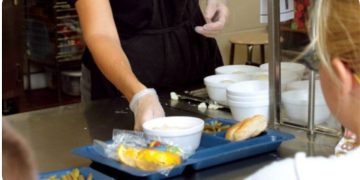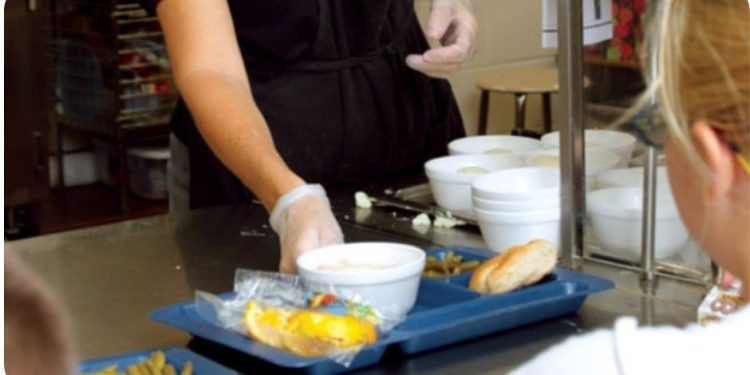Students are back in school, and DNO Produce is hard at work.
The Columbus, Ohio-based produce distributor and fresh-cut processor has been building a niche in producing snack packs of fresh-cut vegetables and fruits.
A family history
President Tony DiNovo comes from a long line of people in the produce business.
“My grandfather and his brothers started out in produce companies in these little county seats (around Ohio),” DiNovo said. “They had push carts and were doing a little wholesale, back in the early 1900s.”
DiNovo’s family settled in Delaware, Ohio, where they had a produce brokerage and retail market.
“I do recall cutting bananas off the stalk and getting the spiders off, the bugs and snakes and frogs and stuff we used to get off the bananas,” he said.
His family’s wholesale distribution operation mainly catered to independent grocers in central Ohio.
“That went on for quite a few years and then different families started to spin off,” DiNovo said. “I kind of spun off myself and came down here to Columbus and bought what was a cooperative that was supplying most of the chains here in Columbus with local produce.”
It was 1989, and the growers were just as happy to let someone else take over distribution, DiNovo said. Several continue to supply DNO with Ohio-grown produce.
Enter fresh cut Several years later, DiNovo bought the assets of two small companies his had been supplying that were producing fresh-cut produce.
Several years later, DiNovo bought the assets of two small companies his had been supplying that were producing fresh-cut produce.
“One of them was more of a foodservice-type guy, with potatoes, cabbage and things like that, and the other was a retail guy,” DiNovo said. “He was doing things like stir fry and carrot sticks — things like that.”
DNO continued to cater to foodservice and retail customers with its new fresh-cut capabilities, then turned its attention to the Columbus city schools in the mid 1990s.
“They wanted these little individual packs (of fresh-cut produce),” DiNovo said.
So the company began working with the U.S. departments of defense and agriculture, participating in an intense process that meant bids were submitted at the beginning of the work week and awarded on Wednesday, with delivery of the finished product expected the following Monday.
“You’d find out (on Wednesday) you’ve got big school districts and you’ve got to get all this stuff together, and maybe they only had it in the West because it’s not like you can get fresh produce from Ohio in the winter,” DiNovo said.
A saving grace was the company’s ability to do its own fresh-cut processing by then.
“If the truck didn’t make it, we could make it ourselves,” DiNovo said. “So that gave us a little bit of an advantage.
“It was kind of the beginning of the fresh-cut thing in schools. They were interested in stuff like this because it laid flat, was portion controlled and already washed and cleaned.”
Learning what works
Building the fresh-cut operation was a learning curve.
 “We got the people we needed as we needed them and tried to get as much expertise in different areas,” DiNovo said. “Food safety is undoubtedly the most important, and we got a lot of that from the trade, from the processing association we belonged to, and just staying in touch with the USDA, the Ohio Department of Agriculture.”
“We got the people we needed as we needed them and tried to get as much expertise in different areas,” DiNovo said. “Food safety is undoubtedly the most important, and we got a lot of that from the trade, from the processing association we belonged to, and just staying in touch with the USDA, the Ohio Department of Agriculture.”
The company also hired someone to handle quality control.
Through trial and error, the company developed products and mixes of products that would work in the snack packs: carrots and radishes, oranges and grapefruit, turnips and radishes, grapes. They often try blends at the request of individual schools as well.
“We learned from the schools what they wanted, why they wanted it and why they needed it,” he said.
The company has also continued to produce fresh-cut items for retail and food processors — a lot of it custom to meet individual customers’ needs.
Moving into a new, larger facility two years ago was a major turning point, DiNovo said, providing much-needed room for more equipment and processing lines. At the same time, wholesale produce distribution remains a dominant part of their operations. They’ve also been repacking and labeling value-added local items for some customers to promote fresh Ohio produce.
The company employs about 100 people.
Right niche, right time
In recent years, requirements by the USDA that schools offer more fresh fruit and vegetables, along with first lady Michelle Obama’s “Let’s Move!” campaign against childhood obesity, have only buoyed DNO’s sales to school districts. In fact, new USDA guidelines effective with this academic year require that schools offer dark green,orange or red vegetables at least once a week and that students must select at least one fruit or vegetable with each meal. In return, USDA will reimburse the schools six cents more per meal to cover the extra expense.
DNO is now serving about 1,000 schools with fresh-cut produce snack packs. About 70 percent goes to distributors, with the company delivering the remainder directly to customers.
 And the market continues to grow as DiNovo’s son, Alex, calls on schools and joins with his father for sales presentations.
And the market continues to grow as DiNovo’s son, Alex, calls on schools and joins with his father for sales presentations.
One foodservice director DNO already works with is Sally Rathje. As head of foodservice for the Delaware City Schools in Ohio, she said the snack packs have enabled her to cut back on labor, while meeting USDA requirements. Of the district’s 5,500 students, between 60 and 70 percent participate in the school lunch program.
“The snack pack has really increased the consumption of fruits and vegetables for us,” Rathje said. “I believe it’s because it’s more like a potato chip bag concept— snacking out of the bag versus something laying on a tray or in a Styrofoam cup.
“And if a student doesn’t want to eat it right away … a lot of them save it for a snack later.”
Rathje orders the packets in half-cup portions.
“The program is designed to eliminate plate waste, so kids can decline some of the items but have to have at least one-half cup of fruit or vegetables on their tray,” she said. “It actually saves us food costs.”


































